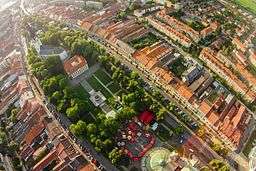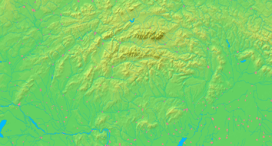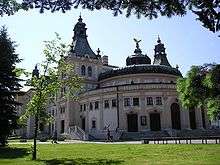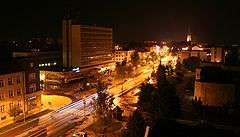Spišská Nová Ves
| Spišská Nová Ves | ||
| Town | ||
 Spisska Nova Ves aerial view | ||
|
||
| Country | Slovakia | |
|---|---|---|
| Region | Košice | |
| District | Spišská Nová Ves | |
| Tourism region | Spiš | |
| River | Hornád | |
| Elevation | 430 m (1,411 ft) | |
| Coordinates | SK 48°56′38″N 20°34′03″E / 48.94389°N 20.56750°ECoordinates: SK 48°56′38″N 20°34′03″E / 48.94389°N 20.56750°E | |
| Area | 66.672 km2 (25.742 sq mi) | |
| Population | 37,795 (2013-12-31) | |
| Density | 567/km2 (1,469/sq mi) | |
| First mentioned | 1268 | |
| Mayor | Ján Volný | |
| Timezone | CET (UTC+1) | |
| - summer (DST) | CEST (UTC+2) | |
| Postal code | 052 01 | |
| Area code | +421-53 | |
| Car plate | SN | |
  Location in Slovakia | ||
  Location in the Košice Region | ||
| Wikimedia Commons: Spišská Nová Ves | ||
| Statistics: MOŠ/MIS | ||
| Website: www.mestosnv.sk | ||
Spišská Nová Ves (![]() pronunciation ; German: (Zipser) Neu(en)dorf; Hungarian: Igló; Polish: Nowa Wieś Spiska; is a town in the Košice Region of Slovakia. The town is located southeast of the High Tatras in the Spiš region, and lies on both banks of the Hornád River. It is the biggest town of the Spišská Nová Ves District (okres). As of 2006 the population was 38,357.
pronunciation ; German: (Zipser) Neu(en)dorf; Hungarian: Igló; Polish: Nowa Wieś Spiska; is a town in the Košice Region of Slovakia. The town is located southeast of the High Tatras in the Spiš region, and lies on both banks of the Hornád River. It is the biggest town of the Spišská Nová Ves District (okres). As of 2006 the population was 38,357.
Tourist attractions nearby include the medieval town of Levoča, Spiš Castle and the Slovak Paradise National Park. A biennial music festival, Divertimento musicale, is held here, attracting amateur music ensembles from all over Slovakia.
History
![]() Kingdom of Hungary 1268-1412
Kingdom of Hungary 1268-1412
![]() Kingdom of Poland 1412-1569
Kingdom of Poland 1412-1569
![]() Polish-Lithuanian Commonwealth 1569-1769
Polish-Lithuanian Commonwealth 1569-1769
![]() Habsburg Monarchy 1769-1804
Habsburg Monarchy 1769-1804
![]() Austrian Empire 1804-1867
Austrian Empire 1804-1867
![]() Austria-Hungary 1867-1918
Austria-Hungary 1867-1918
![]() Czechoslovakia 1918-1939
Czechoslovakia 1918-1939
![]() Slovak Republic 1939-1945
Slovak Republic 1939-1945
![]() Czechoslovakia 1945-1990
Czechoslovakia 1945-1990
![]() Czech and Slovak Federative Republic 1990-1992
Czech and Slovak Federative Republic 1990-1992
![]() Slovak Republic 1993–present
Slovak Republic 1993–present
Settlement in the town's region dates to the Neolithic age. There is evidence of a prosperous society that was familiar with copper mining and processing. When the Celts arrived they brought with them advanced iron technology. Celtic coins have been found in the region. During the 6th century, the period known as the Great Migration, Slavic tribes appeared in the Spiš region. During the 10th century the structure of their settlements stabilized and important communication roads were established. The settlement was included within the state of Great Moravia. By the 12th century at the latest a Slovak settlement had been established known as Iglov, situated between Mlynská street (Mill Street) and the Reduta, in the centre of the present town. The settlement suffered greatly from the invading Tatars in the 13th century. Saxon (Carpathian German) colonists were settled here in the 13th century and their settlement became known as "Villa Nova” ("New Town" in Latin) or "Neudorf" ("New Town" in German), covering the area of the present town. Iglov and Neudorf were amalgamated into one town in the second half of the 13th century.
The town received market rights in the 14th century and grew to become an important market town. It became an official mining town in 1380 and had the largest street market in the Kingdom of Hungary. Copper mining was an important activity. The metal was processed in furnaces, which were fuelled with wood from the surrounding forests. A Gothic bell foundry was established by Konrád Gaal who made a large hanging bell for Louis I of Hungary, and was consequently knighted in 1357. The bells made by Konrád Gaal are still hanging and form an important conlegacy of European Gothic metal foundry.
In 1412 Spišská Nová Ves, along with several other Spiš towns, was pawned as loan security by the Hungarian king Sigmund to the Polish king Vladislaus II Jagiełło. This pledge lasted for 360 years.
Blacksmiths were the first local craftsmen to unite into a guild, which was given royal privileges in 1436. They smelted their own ore, or built water-driven forges along the rivers Hornád and Dubnica. Coppersmiths made kettles of a specifically defined weight because kettles were widely used as a means of payment. There were charcoal burners and even resin pickers who collected resin from trees to produce tar for greasing wagons. There were wheelwrights, coopers, weavers, joiners, gunsmiths, basketmakers, bakers, furriers, tanners, cooks and millers, hunters, fishermen and beekeepers.

There were many Germans living in Spiš and through their influence the town became Lutheran in the 1540s. Between 1569 and 1674 Catholic services were forbidden in the pawned towns. There were many contacts with Poland and this helped to stimulate the national consciousness of the Slovak people. The pawned towns were returned to the Kingdom of Hungary in 1772. In 1778 Spišská Nová Ves became the capital of the "Province of 16 Szepes towns".
In the 19th century the manufacture of stoneware was important in the town. The products all bore a trademark formed from the word “Iglo” with two crossed miners’ hammers. Other industrial activities included oil production and a weaving plant as well as agricultural machines. The railway provided an important means of communication from 1870. A power station was built in 1894 and living conditions improved. In July 1929 the Podtatranská výstava (Sub-Tatras Exhibition) showed results of economic growth and made the town famous in Slovakia. During World War II, Spišská Nova Ves was taken by Soviet troops of the 18th Army on 27 January 1945.
Spišská Nová Ves today

Spišská Nová Ves is a popular tourist attraction today, both because of the town itself and because of the unique natural beauty of the nearby Slovak Paradise mountains. The core of the town is a lens-shaped square (a square with bulging sides), typical of medieval towns. It is a cultural, administrative and business centre of the Spiš region, and is rich in art and historical monuments.
Foremost is the three-naved Gothic church of the Assumption of the Virgin Mary standing in the centre of the town. Its construction dates back to the 14th century and its architecture has been partly preserved. The bas-relief of the Virgin Mary's Coronation on the Gothic tympanum on the south portal of the church is considered to be amongst the most beautiful in the Spiš region. It contains carvings by Master Paul of Levoča. The side pillars are topped by Gothic pinnacles terminating in crossed rosettes. A rosette with tracery crowns the entrance of the church. The tower is 87m high, the tallest church tower in Slovakia. The neogothic top of the tower dates from 1893 and was executed by the architect Imrich Steindl. The neogothic altar dates from the end of the 19th century. The church contains several liturgical treasures : a cross-shaped silver (and partly gilded) reliquary by the Sienese court jeweller Nicolas Gallicus (first half of the 14th century - but the initials NC may also refer to a possible contributor Nicolaus Castellanus), a silver (partly gilded) crucifix and monstrance attributed to Antonio from Košice (early 16th century), a chalice by Jan Kolbenhayer (1795) and a rare bronze baptismal font (second half 13th century). The Calvary Group (1520) is another masterpiece from the workshop of the Master Paul of Levoča. The church vaulted ceiling contains early renaissance paintings with the Evangelists and four angels playing on musical instruments.
The Evangelical church, standing next to the town hall, was built in Classicist style between 1790 and 1796. It has a cross-shaped ground plan. Inside one can see an altar piece of Christ on the Mount of Olives, painted by Danish painter Stunder. The water well is decorated with an alabaster relief of Christ with the Good Samaritan.
Another valuable architectural monument is the Province House, now housing the Spiš museum. It has a baroque façade, but the basement dates from the 13th century. This house was the town hall from the Middle Ages until 1777. The peace treaty between John Jiskra of Brandýs and the Hungarian king Vladislav was signed here in 1443. Its façade includes the underpass "Levoca gate" with in the middle of its arch the crest of the Province of XVI Spiš towns. The upper part of the façade is decorated with rococo stucco motives (rocaille) representing in Latin the moral qualities required of a town official : (from left to right) PONDERE SOLO (According to importance only), UTQUIS MERETUR (as one deserves), SUUM CUIQUE (give everyone his due), DIE NOCTUQUE (day and night), IN SOMNIS CUSTOS (guardian during sleep), HINC OCULOS NUSQUAM (not turning his eyes away).
The Town Hall was built between 1777-1779 in the Classical style, and was reconstructed in the mid-1990s. The main façade faces south while the main entrance is on the north side. The south façade has three big arched windows situated between four semi-columns under a massive tympanum. One can see within the tympanum the city's coat-of-arms between two griffins.The two inner columns have Ionic capitals. The council chamber occupies two floors and is lavishly decorated with pilasters and sgraffito with motifs of drapery alternating with the city coat-of-arms.
The theatre building "Reduta" was built in art-nouveau style between 1899 and 1902 by the Budapest architect Koloman Gerster. He divided its northern and southern part by a risalith (a projection jutting out of the façade). He accentuated the corners of the building by four turrets. He prolongated the western part into a semicircular vestibule. The stage wall is decorated with murals by the local painter Jozef Hanula. Today the building combines a theatre, a richly decorated concert hall and a restaurant.[1]
Demographics
According to the 2001 census, the town had 39,193 inhabitants. 94.21% of inhabitants were Slovaks, 1.93% Roma and 0.51% Czechs.[2] The religious makeup was 69.81% Roman Catholics, 16.95% people with no religious affiliation, 3.17% Lutherans and 3.05% Greek Catholics.[2]
Transport
Spišská Nová Ves railway station is a junction between the Košice–Žilina railway, which is part of Slovakia's main east-west rail corridor, and a 12 km (7.5 mi) spur line to Levoča. Regular passenger services on the spur line have been suspended since 2003.
International relations
Twin towns – Sister cities
Spišská Nová Ves is twinned with:
|
References
- ↑ Kosicky kraj
- 1 2 "Municipal Statistics". Statistical Office of the Slovak republic. Archived from the original on 2008-01-11. Retrieved 2008-01-12.
- ↑ "L'Aigle découverte - Nos villes jumelles". Ville de L'Aigle. Retrieved 2013-07-20.
- Spišská Nová Ves: 1268-1998: 730 rokov prvej písomnej spravy; ISBN 80-967906-8-4
